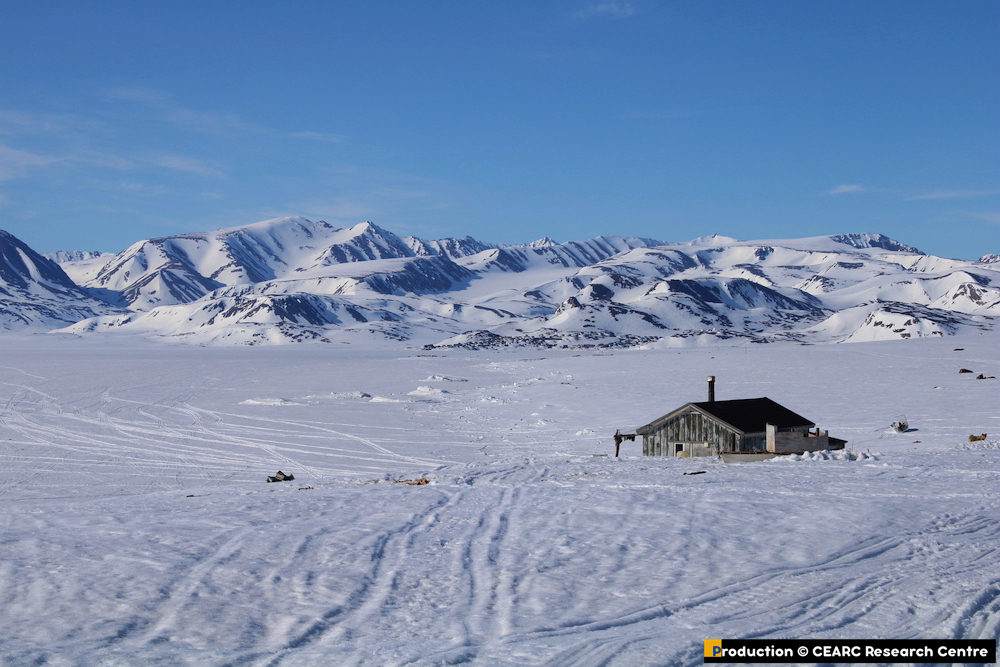Ittoqqortoormiit from Unnartoq / Ittoqqortoormiit vue d’Unnartoq
19 May 2022. From the village of Ittoqqortoormiit, looking east towards the mouth of the fjord, you can see the hamlet of Unnartoq, located 7 km away as the crow flies. From this place, in return, one has a singular sight on the village. This year, the entrance of the fjord is entirely covered with ice, it has not happened for 20 years. All this ice as far as the eye can see, explains the absence of animals which are usually very numerous around the hamlet. "The ice is very far away this year, it must be hard for the hunters. You have to go farther to hunt.
This hamlet of about twenty houses along the cape was closed at the end of the 1980s, the electricity was cut off, and the inhabitants were relocated to the larger town of Ittoqqortoormiit. However, the houses were not abandoned. Many have kept them and now consider this place a valuable vacation spot from which to escape the hustle and bustle of the village. It is also the place where one goes to observe the polynya, that area of ice-free water that usually attracts many marine mammals. Finally, it is the privileged observation post for bears. Every winter, Evald, among others, comes to settle in his old house, with his binoculars and spend hours observing the lord of the place, counting them. He keeps a register for several years in which he notes all his observations. For example, in 2019, he observed 153 bears from January to mid-April. He also notes the day when the quota of 35 bears allowed for professional hunters in the village is reached; it was April 16 in 2019, the 22nd in 2020.
Unnartoq looks out to both the vastness of the ocean to the east and the vastness of the fjord to the west, the quality of the silence, the clarity of the air and the clarity of the view are conducive to contemplation.

by / par Jeanne Gerardi
19 mai 2022. Du village d’Ittoqqortoormiit, en regardant vers l’est, vers l’embouchure du fjord, on aperçoit le hameau de Unnartoq, situé à 7 km à vol d’oiseau. De cet endroit, en retour, on a une vue singulière sur le village. Cette année, l’entrée du fjord est entièrement englacée, cela fait 20 ans que cela ne s’est pas produit. Toute cette glace à perte de vue, explique l’absence d’animaux qui sont habituellement très nombreux autour du hameau. ‘The ice is very far away this year; it must be hard for the hunters’. Les conditions d’englacement inhabituelles de cette année modifient les habitudes qui se sont installées ces dernières décennies. Il faut aller plus loin pour chasser.
Ce hameau d’une vingtaine de maisons disposées le long du cap, a été fermé à la fin des années 80, l’électricité a été coupée, et les habitant·es relogé·es dans le bourg plus important d’Ittoqqortoormiit. Pour autant, les maisons n’ont pas été abandonnées. Beaucoup les ont conservées et considèrent à présent cet endroit comme un précieux lieu de villégiature d’où ils peuvent échapper à l’agitation du village. C’est aussi l’endroit où l’on va se poster pour observer la polynie, cette zone d’eau libre de glace qui habituellement attire de nombreux mammifères marins. C’est enfin le poste privilégié d’observation des ours. Chaque hiver, Evald, parmi d’autres, vient s’installer dans son ancienne maison, avec ses jumelles et passent des heures à observer le seigneur des lieux, à les compter. Il tient un registre depuis plusieurs années dans lequel il note toutes ses observations. Par exemple en 2019, il a observé 153 ours de janvier à mi-avril. Il note également le jour où le quota des 35 ours autorisés pour les chasseurs professionnels du village est atteint ; c’était le 16 avril en 2019, le 22 en 2020.
Unnartoq regarde à la fois vers l’immensité océanique à l’est et l’immensité du fjord vers l’ouest, la qualité du silence, la limpidité de l’air et la clarté de la vue portent à la contemplation.



